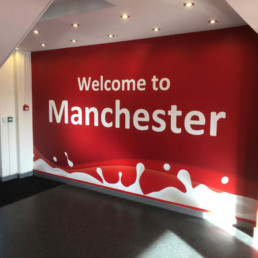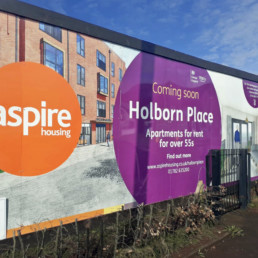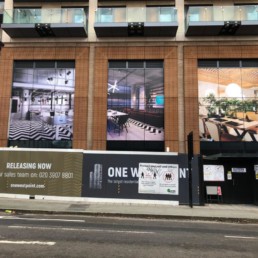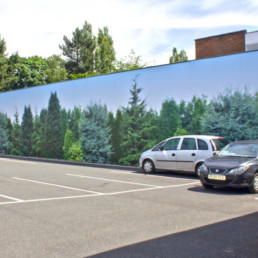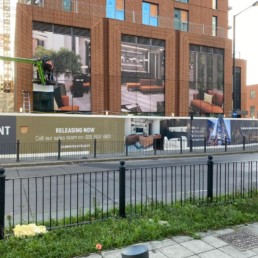At Hardy Signs, we offer an end-to-end signage package. From the initial survey, quote and design to manufacturing and installation, we certainly can provide you with everything you need. Our creative studio is here to support your next projects across the UK.
Three of our graphic designers, Scott Sudale, James Gibbs, and Kyle Timmins took part in a ‘Behind the Scenes’ Q&A session this week. With a wealth of knowledge and experience in their field, the creative team are an integral part of the team here at Hardy Signs. Check out what they had to say about their roles.

Scott Sudale has been working at Hardy Signs since 2011, after studying Graphic Design at Staffordshire University. James Gibbs joined our team almost four years ago, after taking a Graphic Design course at Burton and South Derbyshire College. Kyle Timmins joined the team as an apprentice of the Hardy Signs ‘Sign and Print Academy’ at Burton and South Derbyshire College two years ago.
Q: What is your design process from start to finish?
A – James:
The starting point is where we touch base with the clients. For example, an enquiry comes through the website and marketing sends it to us. We approach the customer via email or call them and ask all the relevant questions, e.g., dimensions, brand guidelines, and a particular design in mind. As soon as the quote gets the green light, we move forward with the project. The project could be anything from a small plaque for a house to a nationwide rebrand that involves various signs.
A – Scott:
To start, we create an initial concept/design and send this to the client. Once they have responded with their feedback (if required), we will develop this and work with the client to get the approval. Once approved by the client, the design is finalised and moved into the relevant folder. The production team then uses this to work. Throughout this process, we make checks to pick up any potential errors.
A – Kyle:
My process starts with a job sheet – which is like a project brief to follow. The job sheet includes all the specifications and is also beneficial to the workshop team.
Q: What is the most important element to remember when designing?
A – James:
Every job is different, so what is essential for one project may be entirely irrelevant to the next. If a company has got strict brand guidelines, we ensure to stick to those at all times. Before I send any job off, I usually print it out and go through it to ensure there are no spelling errors, missed words or punctuation. Depending on the job’s size, I also ask one of my colleagues to proofread – as two pairs of eyes are always better than one.
A – Scott:
The main thing I make sure to remember is continually proof the visuals, making sure I’m picking up any potential errors. Avoiding mistakes is extremely important during the design process.
A – Kyle:
We create thousands of designs at Hardy Signs every year; no two jobs are alike. When I am designing, I make sure the sizes are equal, proofread the spelling, etc. When I’m driving to and from work, I love looking at the signage around, especially vehicle graphics and thinking about what I would do differently or what I like about their design. This process helps me broaden my creative skillset.
Q: What is a project you are most proud of and why?
A – James:
A lot of the jobs I work with are for Müller UK. I like the booklets I create for them; they take quite a lot of time to design and quality-check but undoubtedly very aesthetically pleasing.
A – Scott:
My favourite was probably Bretby Business Park. It was a bit stressful, but I enjoyed getting involved with the photography and editing all of the imagery in Photoshop. They eventually formed Large Format Printed Hoarding Signage, and it was great to see the finished article.
A – Kyle:
I don’t have a specific job that was my favourite as I’m pretty proud of all the jobs I’ve done. There have been a few projects I’ve completed or assisted with over my time here that I’ve enjoyed. We’ve done that many that I can’t pinpoint the one.
Q: Is there anything a client needs to think about when enquiring about signage?
A – James:
Customers need to think about the colours, materials and sizes because different signs will require different elements. For example, you would need ACM (Aluminium Composite Material) for external signage, whereas internal signs would require a material like Foamex. Even when it comes to Wall Graphics, there is a vast range to choose from – you can get pastable wallpaper, or vinyl is another option. It’s up to us to make sure we are using the suitable material, so it’s always good to double-check and explain the different options.
A – Scott:
They need to consider the best material for the location of the signs. If it’s an external sign, the material will need to be durable and weather-resistant so that it is long-lasting. Regarding the design, keeping a safe area around the internal edges and ensuring both the sign/text size is suitable for the requirements. For example, with a large advertising sign, the text would still need to be legible at a distance.
A – Kyle:
Most of our clients think about the sizes and materials beforehand. When they contact us, they have a good idea about what they want it to look like; as designers, it is our job to match that. Depending on the job, we may send the client the design they require and maybe 1 or 2 different versions. This way, the customer has got the option to decide which they prefer and any elements they want to combine.
Each process acts as a step for the next; therefore, a singular error can create a domino effect. The design may seem a small part, but it is the most crucial part in reality. In this stage, the team doesn’t just look at the design itself but also measurements and materials. They need to work out the availability of the production team to be able to advise the customer on a delivery/instalment date. Without all of this, there is room for error, and we must make sure design for manufacturing is a part of the overall process.
Whether working with traditional signage, digital signage, or an online presence – our team calls on years of experience, skills, and knowledge to ensure that the design communicates your message effectively. We’ll encourage you to work closely with the design team to develop your ideas, introduce new concepts and ultimately create the finished article that you’ll be proud of in representing your organisation.
Like what you see here?
Get in touch with us to see how we can help your business or brand.
Call us on 01283 569 102
